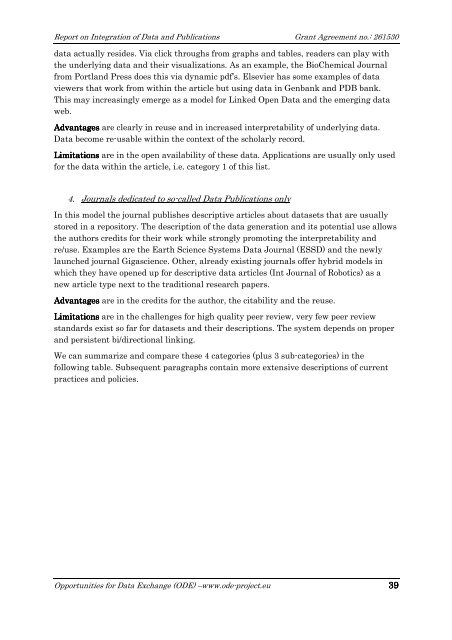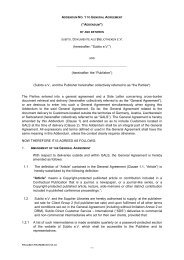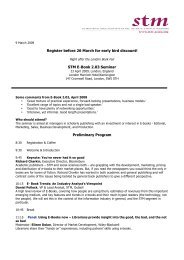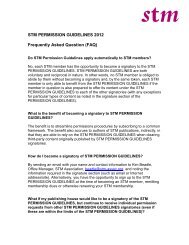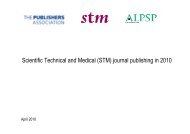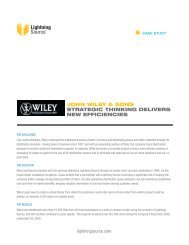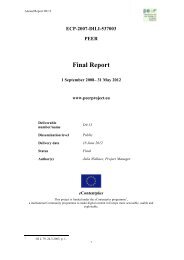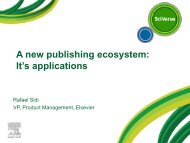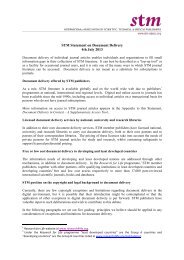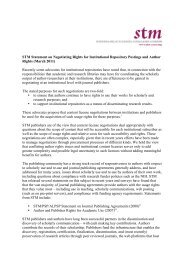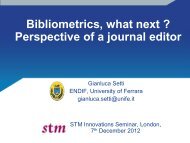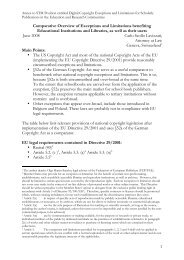Integration of Data and Publications - Alliance for Permanent Access
Integration of Data and Publications - Alliance for Permanent Access
Integration of Data and Publications - Alliance for Permanent Access
You also want an ePaper? Increase the reach of your titles
YUMPU automatically turns print PDFs into web optimized ePapers that Google loves.
Report on <strong>Integration</strong> <strong>of</strong> <strong>Data</strong> <strong>and</strong> <strong>Publications</strong> Grant Agreement no.: 261530<br />
data actually resides. Via click throughs from graphs <strong>and</strong> tables, readers can play with<br />
the underlying data <strong>and</strong> their visualizations. As an example, the BioChemical Journal<br />
from Portl<strong>and</strong> Press does this via dynamic pdf’s. Elsevier has some examples <strong>of</strong> data<br />
viewers that work from within the article but using data in Genbank <strong>and</strong> PDB bank.<br />
This may increasingly emerge as a model <strong>for</strong> Linked Open <strong>Data</strong> <strong>and</strong> the emerging data<br />
web.<br />
Advantages are clearly in reuse <strong>and</strong> in increased interpretability <strong>of</strong> underlying data.<br />
<strong>Data</strong> become re-usable within the context <strong>of</strong> the scholarly record.<br />
Limitations are in the open availability <strong>of</strong> these data. Applications are usually only used<br />
<strong>for</strong> the data within the article, i.e. category 1 <strong>of</strong> this list.<br />
4. Journals dedicated to so-called <strong>Data</strong> <strong>Publications</strong> only<br />
In this model the journal publishes descriptive articles about datasets that are usually<br />
stored in a repository. The description <strong>of</strong> the data generation <strong>and</strong> its potential use allows<br />
the authors credits <strong>for</strong> their work while strongly promoting the interpretability <strong>and</strong><br />
re/use. Examples are the Earth Science Systems <strong>Data</strong> Journal (ESSD) <strong>and</strong> the newly<br />
launched journal Gigascience. Other, already existing journals <strong>of</strong>fer hybrid models in<br />
which they have opened up <strong>for</strong> descriptive data articles (Int Journal <strong>of</strong> Robotics) as a<br />
new article type next to the traditional research papers.<br />
Advantages are in the credits <strong>for</strong> the author, the citability <strong>and</strong> the reuse.<br />
Limitations are in the challenges <strong>for</strong> high quality peer review, very few peer review<br />
st<strong>and</strong>ards exist so far <strong>for</strong> datasets <strong>and</strong> their descriptions. The system depends on proper<br />
<strong>and</strong> persistent bi/directional linking.<br />
We can summarize <strong>and</strong> compare these 4 categories (plus 3 sub-categories) in the<br />
following table. Subsequent paragraphs contain more extensive descriptions <strong>of</strong> current<br />
practices <strong>and</strong> policies.<br />
Opportunities <strong>for</strong> <strong>Data</strong> Exchange (ODE) –www.ode-project.eu 39


